The Irish Marine Casualty Investigation Board (MCIB) published its report on the fire and loss of “FV Horizon” off the old head of Kinsale, County Cork, which took place on May 14th, 2021.
The incident
On 11 May 2021 at approximately 02.00 hrs a fishing vessel departed Union Hall, Co. Cork for a gill net fishing trip 30 to 50 NM south of Union Hall. There were four crew onboard and the boat was stocked with food and ice for a seven day trip. The fishing trip was uneventful, and the Skipper reported that there were no problems onboard until the time of the incident. On the evening of 13 May 2021, the vessel was fishing approximately 30 NM south southeast of the Old Head of Kinsale. There were four strings of gill nets deployed in the sea. The crew were resting in their accommodation cabin until the Skipper called them at approximately 20.50 hrs to haul the nets.
[smlsubform prepend=”GET THE SAFETY4SEA IN YOUR INBOX!” showname=false emailtxt=”” emailholder=”Enter your email address” showsubmit=true submittxt=”Submit” jsthanks=false thankyou=”Thank you for subscribing to our mailing list”]
The crew got up, had tea in the galley and started hauling the nets shortly after 21.00 hrs. This activity continued for approximately three hours during which all crew were employed on deck, and no one visited the accommodation cabin or galley. At approximately 01.20 hrs the crew had just finished hauling the nets and were removing and boxing the catch. There were four nets onboard, two of which were to be deployed as soon as the vessel moved its new fishing location approximately ten to 15 minutes steaming time away. The crew sorted and boxed up the catch while the Skipper moved the boat. The Skipper briefly left the wheelhouse to tie on some fishing buoys to the outgoing net. When he returned to the wheelhouse, he noticed smoke around the accommodation cabin door in the galley. The door was just visible across the galley flat through the aft door of the wheelhouse.
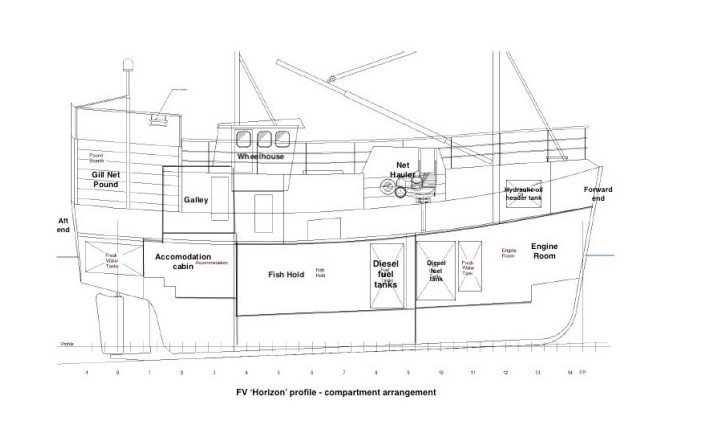
The Skipper descended the three steps down into the galley flat and grabbed an extinguisher. He could see down into the accommodation cabin where there was thick smoke and tried to enter the accommodation flat via the access ladder to investigate the source of the smoke. He was able to descend a few rungs of the ladder but unable to enter the cabin or seek out the source of the fire as he was beaten back by smoke. As the Skipper withdrew from the access ladder hatchway, he closed up the accommodation door before running out to the main deck and alerting the crew. The Skipper stated that the smoke detector/fire alarm located in the deckhead of the accommodation cabin did not go off but that the smoke alarm in the galley sounded off when the smoke entered the galley space.
The Skipper directed two of the crew to release and launch the life raft and the other crewmember to gather the survival suits and emergency gear from
the wheelhouse deck store and muster on the top deck while he again attempted to tackle the source of the smoke with fire extinguishers. When he opened the accommodation door he was immediately beaten back, choking with smoke which he described as dark but not with a burned “plasticky”. smell. He sensed a lot of heat and could hear the crackle of a fire below in the cabin. Overcome with the smoke the Skipper ran onto deck. He saw the life raft launched and tied its painter to the rail. The Skipper realised at this point that the fire was serious and beyond the ability of the crew to extinguish with the equipment he had onboard. He went back into the wheelhouse and made a distress ‘MAYDAY’ broadcast from the marine VHF radio. The time was 01.40 hrs and the broadcast was received by Valentia Coastguard radio who re-broadcast the ‘MAYDAY’ distress call to all ships in the vicinity.
The fire continued to grow and take hold and smoke was coming out of the galley. The Skipper had not shut down the engine although he had disengaged the clutch and the vessel was drifting. The main engine powered a deck wash sweater pump with a 1 ½ inch diameter deck wash hose which was charged, and he brought this into the wheelhouse and directed the water jet directly across the galley and down the accommodation cabin access hatchway. The Skipper recounted that he increased the main engine speed to power up the deck wash pump to its maximum operating pressure. However, fire extinguishers and the deck wash water jet were ineffectual at fighting the fire. After a couple of minutes fighting the fire and directing the water jet the Skipper again became overcome with the effects of smoke so he closed and attempted to seal the wheelhouse door leading to the galley to retard the spread of the conflagration. He estimated the time was approximately 01.50 hrs.
The Skipper recounted that the spread of the fire was “shockingly” rapid. The vessel filled with smoke, and he could see the flames of the fire quickly gaining
strength. Realising the fire had spread to the galley and the firefighting water jet had proved to be ineffectual the Skipper made the decision to abandon ship and told the crew to board the life raft. The Skipper brought with him the Emergency Position Indicating Radio Beacon (EPIRB), Search and Rescue Radar Transponder (SART) and handheld VHF radio into the life raft. The fire had by now broken out onto the after-deck area which was now ablaze and fuelled by the plastic nets stowed onboard in the net pound and the stored gas in the LPG systems in and around the galley at the stern of the vessel. The crew manoeuvred the life raft away from the burning vessel.
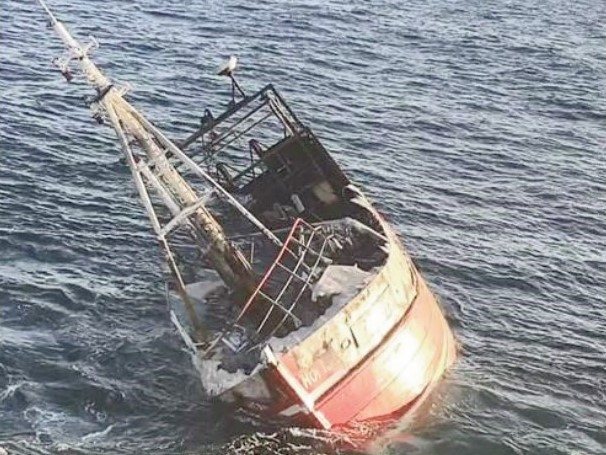
The Skipper recounted that despite the vessel being ablaze, the vessel was stable and relatively upright with no visible list. The fire was melting the aluminium
shelter deck and travelling along the rigging and cordage from the wheelhouse. Plastic fish boxes and floats were also on fire and the heat was intense. The Fast Rescue Craft (FRC) from the ship “Pathfinder” arrived at 02.19 hrs. The crew were taken from the life raft onto the FRC which immediately returned to the parent ship. Once onboard the ship “Pathfinder” the crew were medically checked and found to have suffered no lasting ill effects from their experience. At 03.28 hrs the crew were transferred to the Courtmacsherry Lifeboat which immediately proceeded back to Courtmacsherry to land ashore the four crewmembers.
The ship “Maersk Maker” with onboard firefighting capabilities arrived on scene at 02.30 hrs and attempted to extinguish the fire onboard the vessel. However, despite initially reducing the fire the ship reported at 02.58 hrs that the fire continued in the vessel’s after end. The ship “Maersk Maker” reported the fire was extinguished at 03.40 hrs. The vessel was monitored by the IRCG helicopter, the ship “Maersk Maker” and the naval patrol vessel “L.E. George Bernard Shaw” and reported sunk shortly before 06.49 hrs close to the position where it initially caught fire.
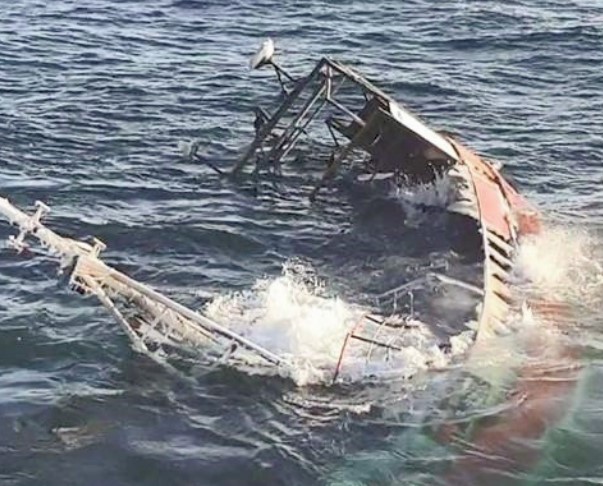
Analysis
#1 Condition of the Vessel: The vessel was surveyed and gained its full FVSC in 2018. An Interim FVSC survey was carried out by the MSO in October 2020 and the vessel approved for its Interim FVSC. The vessel was again surveyed on 25 November 2020 and a vessel stability check was carried out satisfactorily at that time. The fishing vessel was approved by the MSO to continue its fishing activities. There had been no major changes or modifications to the vessel in the intervening time up to the time of the incident. It would be reasonable to deduce that the vessel was materially fit for purpose and in a stable condition immediately prior to the incident and the vessel’s condition was not a factor in the fire and loss of the fishing vessel.
#2 The fire: The fire was central to the incident and ultimately led to the sinking and loss of the vessel. The vessel had been fishing the three previous days and
the Skipper reported that there were no problems onboard prior to the incident. When the Skipper first noticed the smoke issuing out from the accommodation cabin, he attempted to seek out the source of the fire and was able to descend halfway down the accommodation access ladder before being beaten back by
smoke. It can therefore be deduced that the fire started in the accommodation cabin. The accommodation cabin was safeguarded against fire by having a smoke detector alarm fitted. The Skipper stated that the alarm failed to operate. Whether the fire detection system smoke alarm did sound but was not heard or whether it failed to operate is not known with any certainty.
Although the fire alarm system was inspected in order to pass its FVSC process in October 2020 the accommodation flat smoke detector alarm was not heard by the Skipper when he first noticed smoke, which indicates that the smoke alarm did not function
correctly and this was likely due to either; a recent defect arising in the alarm system, the component was damaged by the fire itself before it could sound, or, there was a longer standing defect that should have been revealed during the regular monthly testing check of the fire detection system. The Skipper stated
that the monthly checks were done but there is no record as to when the system was last tested as the vessel’s onboard records were lost in the incident.
Regulation S.I. 640 of 2007 states the following:
Inspections. 131.
(a) Inspections of the life-saving equipment and fire appliances shall be made at intervals of not more than one month.
(b) A report of the inspection shall be entered in the logbook.
It may be deduced that the routine for checking the fire detector smoke alarms operation was inadequate in that the faulty operation of the smoke alarm
remained undetected until the outbreak of the fire. If the smoke detector alarm in the accommodation had operated correctly the Skipper and crew may have been able to extinguish the fire before it spread and developed into a conflagration. The time delay (in fighting the fire) caused by the failure of the smoke detector alarm allowed the fire to take hold and spread before being spotted by the Skipper when he returned to the wheelhouse. The failure of the smoke detector alarm was a causative factor to the spread of the fire onboard the vessel.
#3 Fire Detection System: The vessel’s fire detection system was ineffectual in that the smoke detector alarm located in the accommodation cabin failed to operate. The smoke detector alarm in the galley operated, but by then the fire had taken hold and was rapidly spreading. Had the fire detection system been more in-line with the more stringent requirements of the International Fire Safety Systems (FSS) Code which requires the fire detection system to include both audible and visual fault signals, the fire in the accommodation cabin would likely have been detected earlier. The vessel was an “existing vessel” in 2007 when S.I. 640 of 2007 was promulgated. Therefore, the previous requirements of Regulation 80(17) of S.I. 640 of 2007 applied to the fire detection system on “FV Horizon” and only audible smoke detector alarms were required and fitted. The less modern requirements of Regulation 80(17) of S.I. 640 of 2007 which applied to the fire detection system on “FV Horizon” was considered a contributory factor in the late or untimely detection of the fire in the accommodation cabin.
80(17) The Minister will accept the fire protection, detection and extinguishing arrangements on existing vessels providing they comply with and are maintained in accordance with previous requirements under the Merchant Shipping (Fire Appliance) Rules 1967 (S.I. No. 100 of 1967) and continue to
remain efficient in service
#4 Source of Ignition of the Fire: The Skipper stated that he was unable to see or detect the source of the fire in the cabin but that there was no reason to think that spontaneous combustion of any of the cabin contents was the cause of the fire. Therefore, it may be deduced that the only other possible source of an ignition in the unattended cabin would be by an electrical defect. There were electrical circuits and devices in the cabin, and it was surmised that the fire may have been initiated by an electrical problem either in the circuits or an electrical device or a combination of both.
The cabin was wired with two electrical circuits. A 24V DC circuit for the cabin lights and magnetic compass repeater and a 240V AC circuit supplying the
electrical sockets. The Skipper stated that the bunk electrical sockets were disconnected previously and out of commission. The cabin was lit by two 24V DC LED light devices. LED by their nature do not generate significant amounts of heat and therefore do not carry a great fire risk. The magnetic compass repeater was also low power 24V DC and did not use a lot of power or generate any great amount of heat. Therefore, it may reasonably be deduced that the 24V DC LED lights or compass repeater light could be discounted as being the source of ignition for this fire and was not a factor in this incident.
There were no deficiencies reported in the vessel’s electrical installation in the 6 October 2021 FVSC survey with regard to the Merchant Shipping (Safety of Fishing Vessels) Regulations 2007, Part 4, Regulation 67, electrical distribution and Regulation 68, cables which had been passed for certification purposes. Therefore, it can reasonably be deduced that the electrical installation onboard “FV Horizon” was compliant with the regulation at the time of the FVSC inspection in October 2020.
The Skipper stated to the Marine Casualty Investigation Board (MCIB) that there had been no changes made to the electrical system in the intervening period of time up to the incident on 14 May 2021. Therefore, it can reasonably be deduced that a fault in the electrical circuits did not provide a source of ignition for the fire in the accommodation and was not a factor in this incident.
The crew each had mobile phones. These electronic devices contain lithium batteries and require re-charging, usually from a 240V AC electrical power socket and there was a 240V AC circuit in the cabin with sockets. It was probable that electronic devices were in the cabin as the vessel was 30 NM offshore (and likely out of mobile phone coverage) and therefore not in use by the crew. Lithium batteries are commonly damaged when overcharged and become prone to overheating and even igniting in some instances. Electronic device battery chargers also carry a risk of overheating and igniting and should not be operated near combustible materials or left unattended.
The galley and accommodation cabin 240V AC sockets were regularly used by the crew for charging the batteries of their electronic devices. It is surmised that one or more of these devices were in the accommodation cabin and may have been plugged into the 240V AC sockets, unattended, while the crew were working on deck. It would be reasonable to deduce that an unattended mobile phone or other similar electronic device in the process of being charged and/or an electronic device battery charger may have been the source of ignition for this fire and may therefore, present a causative factor for the fire onboard the vessel.
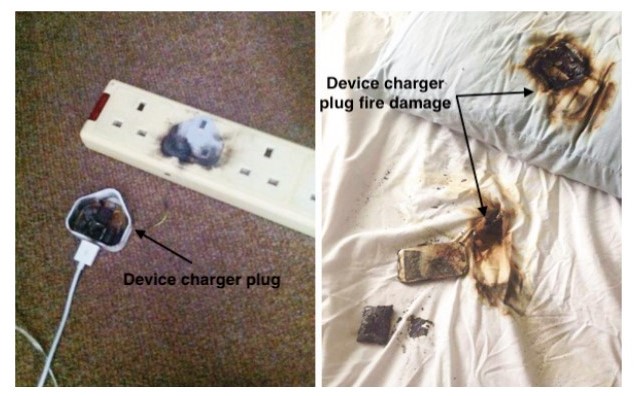
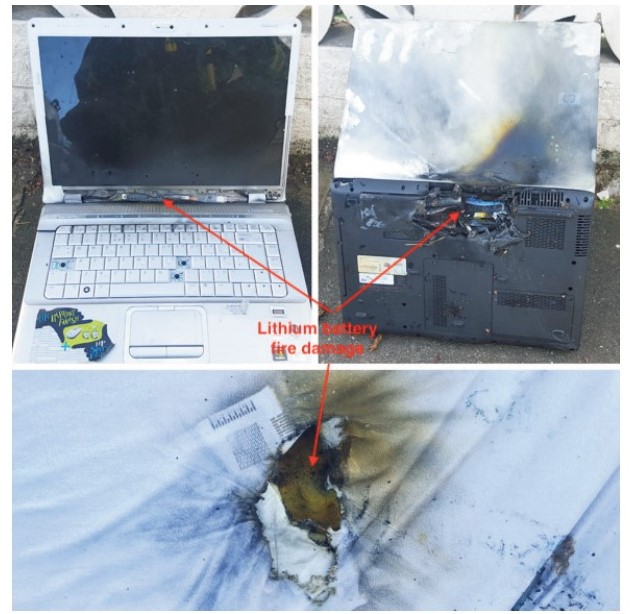
The crew statements indicated they were all on deck attending the nets for fishing at the time of the discovery of the fire. The Skipper stated that there was no one in the galley for some time before the fire. The gas installation onboard “FV Horizon” was compliant with the regulation at the time of the FVSC inspection in October 2020. The Skipper stated to the MCIB that there had been no changes made to the gas system in the intervening period of time up to the
incident on 14 May 2021. Therefore, it can reasonably be deduced the gas installation was not the source of the ignition of the fire and not a factor in the loss of the vessel.
#5 Spread of the Fire: On his second attempt to re-enter the accommodation cabin the smoke was denser, and the Skipper was unable to attempt to descend the ladder to extinguish the fire. At that time, he stated he felt heat and heard a crackling noise (presumably from the fire) before he closed the access door. The
fire took hold and spread, and it likely burned through the bulkheads separating the accommodation cabin from the galley and fish hold. Despite using the water jet from the deck wash system, the fire continued un-abated. Various other combustible materials became exposed to the fire, plastic containers of diesel
fuel and hydraulic oil being the main sources of combustion material. The Skipper stated that there were also pyrotechnics stored in the wheelhouse. The propane gas bottles were located outside the galley on the main deck and within reach of the fire after it broke out of the accommodation cabin and into the
galley, wheelhouse and after-deck. The Skipper stated that he heard the gas bottles exploding and saw the fire travelling along the rigging forward to the shelter deck.
The fire burned through the wood bulkhead between the accommodation cabin and fish hold where the wooden battens, plastic insulation materials, plastic fish boxes, two diesel oil fuel tanks and wooden deck construction provided sufficient amount of readily combustible materials to fuel and accelerate the conflagration below decks. Likewise, the fire reached the engine room by way of the wooden bulkhead between the fish hold and the engine room. The engine room was bounded by a wooden construction in the bulkheads, deck head and hull sides. The compartment also contained large amounts of fuel, lubricants, greases and plastics. The combustible materials commonly used onboard the “FV Horizon” (a wood constructed fishing vessel), particularly the amounts of stored LPG, plastic and oil onboard, provided adequate fuel for the fire to enable it to rapidly spread through the vessel and is considered a causative factor to the proliferation and extent of the fire onboard the “FV Horizon”.
#6 Cause of the Sinking: When the fire reached and burned through into the engineroom, all plastic components in the engineroom machinery, engineroom equipment and associated systems, and oil contained in the oil tanks and oil systems, provided fuel to accelerate the fire.
The Skipper’s early attempts to extinguish the fire using the vessel’s deck wash hose and the fire extinguishing attempts by the crew of “Maersk Maker” put an
unknown amount of water onto the burning “FV Horizon”. The amount of seawater put onboard by both firefighting attempts was unlikely to have singularly caused the vessel to sink as the vessel remained afloat for approximately two and a quarter hours after firefighting attempts had finished. The extent of the fire damage to the vessel was extensive; the engine room was burned out and the vessel was likely taking in water through its seawater cooling hull valves which eventually proved to be fatal to the vessel’s watertight integrity as the vessel sank shortly before 07.00 hrs approximately six hours after the outbreak of the fire. Firefighting efforts by the Skipper and the crew of the ship “Maersk Maker” are not considered to be causative or contributory factors in the sinking of “FV Horizon”.
The Skipper stated that the main engine and the fish hold refrigeration system were cooled each with seawater drawn directly through two separate pipe systems from the sea through the vessel’s hull mounted seawater inlet valves located on the hull beneath the vessel’s water line. These systems had sections of reinforced flexible plastic hoses connecting the pipework from the seawater valves to the machinery cooling systems. These hoses, when exposed to fire, melt and fail allowing an uninterrupted flow of seawater into the engine room compartment. The seawater flowing into the engine room would fill into the adjoining compartments as the bulkheads were burned through and eventually the water would fill the vessel which would sink. It can therefore be deduced that the fire was a causative factor in the sinking of the “FV Horizon” in that the intense heat of the fire melted the plastic components of the vessel’s machinery cooling systems which lost their watertight integrity allowing seawater into the vessel to the extent that “FV Horizon” filled with seawater and sunk.
It can also be deduced that the absence of fire proofing materials in the flexible hose components of the vessel’s machinery cooling systems (connecting the cooling systems to the sea through the hull mounted sea valves), caused these to melt. It is deduced that, as the hoses melted, the sea was allowed to flood into the vessel through the cooling systems hull mounted sea valves and was a causative factor in the sinking of the vessel.
#7 Crew Training and Competence: The efforts by the crew of “FV Horizon” in fighting the fire and preparing the emergency equipment prior to leaving the burning vessel in the life raft without injuries was assisted by a number of converging factors:
- The crew being at one location and above the lower decks enabled, firstly a rapid response to the developing emergency and secondly, timely deployment of the crew’s survival equipment and vessel’s life raft.
- The weather conditions at the time of the incident were good which greatly aided the subsequent search and rescue operation.
- The crew successfully launched the life raft and abandoned the burning vessel with no difficulties or injuries.
This demonstrates the effectiveness of the emergency procedures training provided through the BIM Safety Training scheme to the Skipper and one of the crew members. However, it must be noted that the other two crewmembers did not have the required BIM safety training courses completed. All fishing vessel crewmembers are required to undergo basic safety training as per S.I. 587 of 2001 – Fishing Vessel (Basic Safety Training) Regulations which states:
Basic Safety Training
4. (1) Every crew member of a fishing vessel shall undertake basic safety training as set out in this regulation.
(2) Basic safety training shall consist of the following 3 training units-
- (a) personal survival techniques, including man overboard techniques,
- (b) elementary first aid, and
- (c) fire prevention, health and safety training, and shall be held in such establishments, to such standards, under such conditions and for such duration as BIM may approve and determine.
(3) The dates by which basic safety training must have been completed by each crew member are specified in the Table to this Regulation.
(4) A crew member who has not successfully completed basic safety training by the date specified in the Table shall not work onboard a fishing vessel.
If the crew dispositions at the outbreak of the fire and the weather conditions during the incident were not so favourable, then the absence of basic safety training for the two crewmembers could have led to a more negative outcome to this incident. However, the lack of crew training and competency was not a factor in the fire or sinking of “FV Horizon”.
#8 Maritime Safety: The Irish Government’s Maritime Safety Strategy published by the Minister for Transport, Tourism and Sport in 2015 recognised the need for improved safety standards in fishing vessels of similar size and type to the “FV Horizon”. The Irish Maritime Administration (IMA) in pursuit of their strategic objective were to carry out a number of actions, to improve safety standards in the Irish fishing fleet. Two in particular:
- Action 9. The standards for fishing vessels less than 24 metres in length will be updated, incorporating relevant MCIB recommendations. (Start 2015).
- Action 29. An enhanced flag state inspection regime on fishing vessels will be implemented to promote adherence to maritime safety requirement in the sector. (Start 2016)
A review of the effectiveness of the implementation of ‘Action 9’ and ‘Action 29’ of the Maritime Safety Strategy may be required as safety issues relating to vessel stability awareness for fisher crew, vessel undermanning, undocumented foreign nationals working in the fishing industry, lack of safety training and certification among non-national fisher crew are some of the issues identified in MCIB investigations.
Conclusion
The vessel was materially fit for purpose and in a stable condition immediately prior to the incident and the vessel’s condition was not a factor in the fire and loss of “FV Horizon”.
The ignition source for the outbreak of the fire in the “FV Horizon” is not known with any certainty but it is reasonably deduced that an unattended mobile phone or other similar electronic device in the process of being charged and/or an electronic device battery charger into a 240V AC circuit in the crew accommodation cabin may have been the source of ignition for this fire and was a causative factor for the fire onboard the vessel.
The time delay (in fighting the fire) caused by the failure of the smoke detector alarm allowed the fire to take hold and spread before being spotted by the Skipper when he returned to the wheelhouse. The failure of the cabin smoke detector alarm was a causative factor in the spread of the fire onboard the vessel.
The combustible materials commonly used onboard “FV Horizon” (a wood constructed fishing vessel), particularly the amounts of LPG, oils and plastic onboard, provided adequate fuel for the fire. This enabled the fire to rapidly spread through the vessel and was a causative factor in the proliferation and extent of the fire onboard “FV Horizon”.
The exposure of the flexible plastic hose components of the vessel’s machinery cooling systems to the fire in the engine room, allowing them to melt and lose their watertight integrity, thereby allowing seawater into the vessel to the extent that “FV Horizon” filled with seawater and sunk. That was a causative factor in the sinking.
The absence of fire proofing materials in the flexible hose components of the vessel’s machinery cooling systems connecting to the through hull shipside valves allowed seawater to enter the vessel when the flexible hoses melted in the intense heat of the engine room fire. This allowed seawater to flood the vessel and was a causative factor in the sinking of “FV Horizon”.
Had the fire detection system onboard “FV Horizon” been more in-line with the more stringent requirements of the International FSS Code which requires the fire detection system to include both audible and visual fault signals, the fire in the accommodation cabin would likely have been detected earlier. However, “FV Horizon” was an “existing’ vessel” in 2007 when S.I. 640 of 2007 was promulgated. Therefore, the lesser requirements of Regulation 80(17) of S.I. 640 of 2007 applied to the fire detection system on the “FV Horizon” and only audible smoke detector alarms were fitted. The less stringent requirements of Regulation 80(17) of S.I. 640 of 2007 which applied to the vessel’s fire detection system was considered a contributory factor in the late or untimely detection of the fire in the accommodation cabin.
Two of the vessel’s crew did not have the required BIM safety training courses completed. All fishing vessel crewmembers are required to undergo basic safety training as per S.I. 587 of 2001 which is required for any crew who have radio communication duties onboard vessels fitted with GMDSS equipment. GMDSS Radio Operators Certificate is a marine radio ROC.




























































